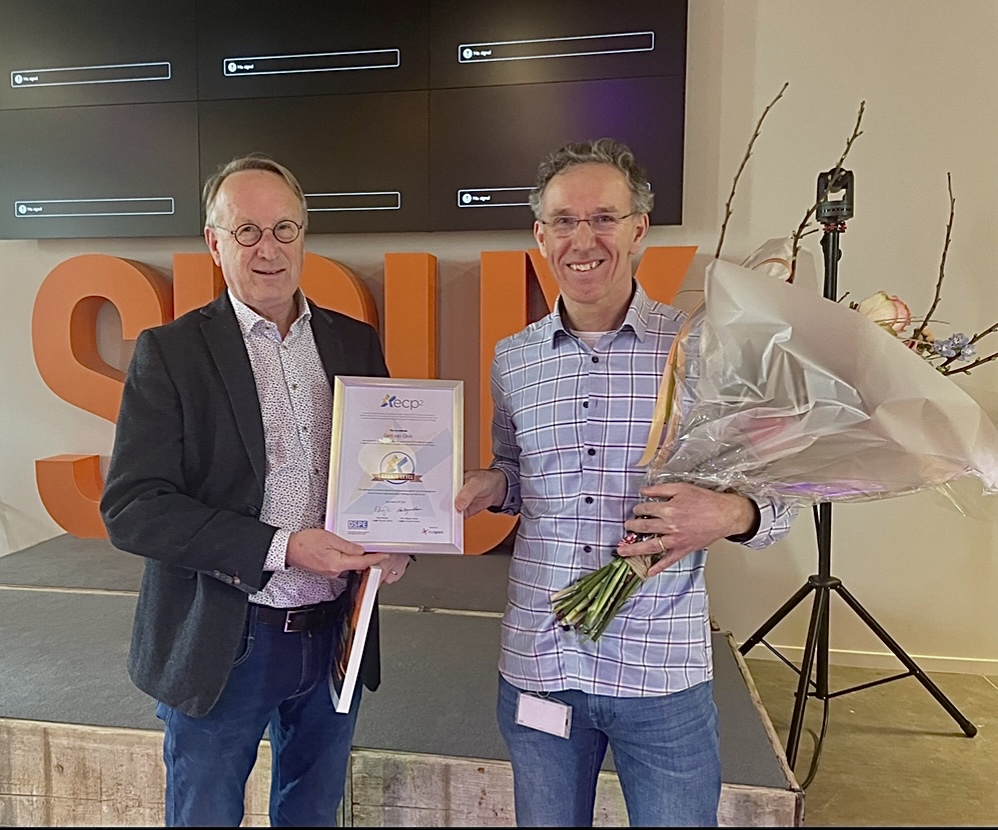ECP2 courses offer benefits to mechatronic projects
Gert van Ooik, principal system designer mechatronics at Sioux Technologies in Eindhoven (NL), has been awarded the Bronze certificate from the ECP2 programme.
ECP2 is a European certified precision engineering course programme, a collaboration between euspen and DSPE. He is the ninth person to receive this certificate since the first one was presented in 2015.

Euspen’s ECP2 programme grew out of DSPE’s Certified Precision Engineer programme, which was developed in the Netherlands in 2008 as a commercially available series of training courses. In 2015, euspen, DSPE’s European counterpart, decided to take certification to a European level. The resulting ECP2 programme reflects industry demand for multidisciplinary system thinking and in-depth knowledge of the relevant disciplines. To promote participation, a certificate scheme was instigated. The Bronze certificate requires 25 points (one point equals roughly one course day), Silver requires 35 points and Gold 45 points, which qualifies a participant for the title ‘Certified Precision Engineer’.
High-tech
Gert van Ooik studied Electrical Engineering at Eindhoven University of Technology and worked subsequently at various high-tech companies in the Brainport Eindhoven region. At ODME, a manufacturer of CD mastering and production machines, he was responsible for the development of testing equipment for masters and CD quality. “I worked on the electronics, the software and the test principle. It was very broad in terms of disciplines and that is still characteristic of my interests.” Next, he worked at IAI in Veldhoven (NL) on laser applications for, among other things, document security solutions. “I was involved in system design and developed embedded software and electronics. At a certain point, the machines concerned became a product and it was from then on a matter of fine-tuning that product. My interest faded.”
CCM/Sioux
Hence, Van Ooik applied for a job at CCM (a mechatronics company that merged into Sioux Technologies in 2014, ed.). “I was attracted by the large pool of disciplines they worked with, from physics and optics to software and control engineering. I really got to learn mechatronics there.” CCM/Sioux is where Van Ooik collected his ECP2 points. “I started with courses that are part of the foundation of mechatronics and were in line with my daily practice: Advanced Motion Control and Motion Control Tuning. If mechatronics is easy, it won’t come to us. When it involves extremely high speed or accuracy, or extreme thermal conditions, it will. For example, the Advanced Motion Control course fitted in perfectly with the design that I was working on at the time, a master-slave long-stroke linear stage with a short-stroke six-axis stage that compensated the guiding errors. If you take your courses at the right time, you can benefit a lot from them.”
Learning control
“Nowadays, we often have projects for cost-effective mass products, for which we have to use low-grade sensors and actuators while still achieving high accuracy in a smart way. Here, learning techniques can help. That’s why I have also taken the Advanced Feedforward & Learning Control course, which I was able to apply, for example, in a project for an extremely accurate mastering machine for both DVDs and Blu-ray discs. I developed a learning technique to deal with repetitive errors, such as unevenness in the rotating master disc, because the required performance of nanometer accuracy at 4 kHz bandwidth could not be achieved with solely feedback-based control.”
Optics
A common thread in many of Van Ooik’s projects is optics; his interest dates back to his youth, when he was a member of De Jonge Onderzoekers (The Young Investigators) and built his own telescope (and computer). He therefore also attended the ECP2-certified Summer school Opto-Mechatronics. “That was a nice, broad course, in which the basic rules for optics were revived, precision engineering aspects were discussed and thermal problems were presented, and you were challenged to devise an appropriate control strategy for an optical delay line in a large telescope. Typically, a task for which you really have to come up with an outside-the-box solution.”
Experiment and calibration
The course Experimental Techniques in Mechatronics is more recent. “At Sioux I am responsible for the investments in equipment for modal analysis. This is becoming increasingly important due to the ever-increasing demands on dynamic behaviour. It gives you more confidence if you can validate your designs not only with FEM simulations but also experimentally.” This year, Van Ooik took the Metrology and Calibration of Mechatronic Systems course. “If you have to achieve high accuracy, you will only succeed if you take the required calibrations into account in the system design.”
Fun
And Van Ooik hasn’t finished learning yet. “My position at Sioux touches on system architecture; I have to understand all disciplines.” So, he also took courses on soft skills and system architecture and is considering the topic of actuators. “Taking a course is also always good for expanding your network and gaining new inspiration from your teachers and fellow students. It’s just fun.”